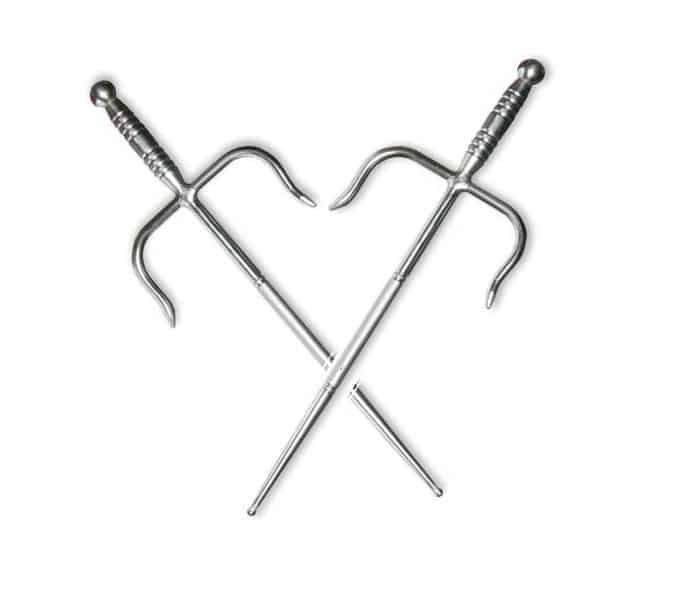
Some basic questions and answers about the Tekpi:
"Is it used individually or two? Is it used against specific weapons as a defensive tool?"
In Silat Melayu, the tekpi has mostly followed the temperament and ideals of the art, so much so that even while the origins of the tekpi is still hotly debated, the technique employed in Silat Melayu is not, since it is accepted as mostly (if not purely) Malay in thought and action.
The tekpi is used both as a singular and a double weapon. As a singular weapon, it is used paired with another bladed weapon. In Silat Melayu, the tekpi takes the place of the cumbersome shield in other cultures that don't employ it this way. Therefore, the dominant hand would hold a keris or a parang (I've been told) or in the case of Silat Kuntau Sendeng, a Pedang and a tekpi (this I've seen personally).
In cases where the tekpi is used as twin weapons, one tekpi held in the submissive hand, will act as the defensive (shield) while the other held in the dominant hand will act as the offensive.
In Silat terminology, this is termed Jantan (offensive position) and Betina (defensive position). In these positions, the Betina will be held in the reverse grip, parrying (not blocking) all incoming
attacks, while the Jantan will be held in the outstretched grip as a stabbing and pukulan weapon. In some cases, the Betina will be slightly heavier and the Jantan slightly lighter. It's not even a
perceptive problem since most of us have 'softer' left hands than our dominant 'hard' right.
The difference in weight is to balance out the abilities of the two hands, strengthen the left. However, this is an exception and very few silat arts employ this concept anymore. Most
arts use the Jantan and Betina positions interchangeably as in the case of Silat Kuntau Tekpi and Silat Kuntau Sendeng. Therefore, when one is defending, the other is attacking. This quick change is an extension of the hands' ability to slip between offence and defence,
unlike the Keris which depends on the different parts of the weapon to facilitate a defensive or offensive mode.
In very Chinese influenced arts such as the Yunnanese-originated LianPadukan (there's a great site on it at http://lianpadukan.com please do check it out), the tekpi is held in Jantan-Jantan position, rarely if ever receding to the Betina position. The weapons form is similar to the butterfly knife forms I've seen in Wing Chun (because they're both Southern Chinese styles). The tekpi is flexible enough to defend against any bladed or blunt weapon. However, its speed and versatility depends largely on the user himself.
Is it used offensively?
Yes, it is used offensively. The main methods used are Tumbuk (punch), Titik (whipstrike), Pukul (strike), Tikam (thrust), Sebat (whip), Tangkap (trap), Kunci (lock), Patah (break), Hentak (slam), Parang (slash) and so on. According to my Silat Kuntau Sendeng teacher, cikgu Jamaludin Shahadan, the Bugis people used to modify their tekpi for war, sharping the tip of the centre prong to a cone-like shape the length of one jengkal, while the rest of the tekpi remained an octagon shape.
In other cases, the last jengkal on the tekpi actually recedes into a proper blade. Both of these variations are used together with a leather armguard worn on the tekpi hand. Although he has never shown me a sample of this, a couple of years back (it's still around, I can probably get a picture of it to you) we discovered an old tekpi that had this conical shape. It was a small pair (even I could barely use it, couldn't execute a couple of moves), which seemed strange to me
because Buginese are huge-built people. This can only mean that this idea wasn't isolated to Bugis warriors, or there actually was a mini-Bugis warrior running around.
"Are the techniques similar to the use of a golok?"
I wouldn't know if Malaysian golok techniques are similar to Indonesian style golok techniques since as I understand it, only the Javanese use the golok. Malaysian styles generally resemble Sumatran in technique and temperament. Most Golok techniques in Malaysia conform to Arabic sword techniques. In Malay they're called Rencong Mengkuang (45 degree uppercut slash), Perpang Gantang (45 degree downward slash), Belah Pinang (a downward centre cut) and Baling
Lembing (the thrust). I could be mistaken since most silat use this, but there could also be those that I haven't seen.
Additionally, cikgu Jamaludin also mentioned that the Maduranese (very hot-tempered Malays from Madura) have very high skill in the cabang. I read once that the late Donn F Draeger once commented on the Indonesian cabang skill (I don't remember which clan he was referring to) surpassed those of Japanese origin.